Lines Can Be Used in Art to Indicate Which of the Following Check All That Apply
What is Line in Terms of Art?
Line is one of the 7 elements of art. It is considered past many to be the about bones chemical element of art. In terms of fine art, line is considered "a moving dot".
A unproblematic mode of thinking of a line is to imagine a point that moves...
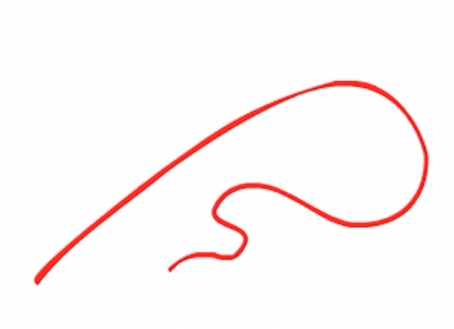
Drawing and Painting with Line
Line has an endless number of uses in the cosmos of both drawings and paintings. Although we typically acquaintance line with drawing, it's also foundational to painting.
Contour Lines
Mayhap the nearly obvious utilise of line is when it is used to define the edges or boundaries of a subject. We tin can obviously communicate a subject'south edges by using line. In most cases, when we begin a drawing, nosotros start past drawing the outlines of the subject.
The outlines are simply the beginning since line is also used to describe the details on the subject too. Usually, we can simplify areas of contrast on a subject field into a line.

In the image beneath, we can see the photo reference next to the resulting line drawing of a flower. The flower is communicated clearly in the line drawing. However, yous'll note that the drawing is not an exact replica of the reference. In that location are only lines used in the drawing, yet in that location are many more complexities present in the photo.
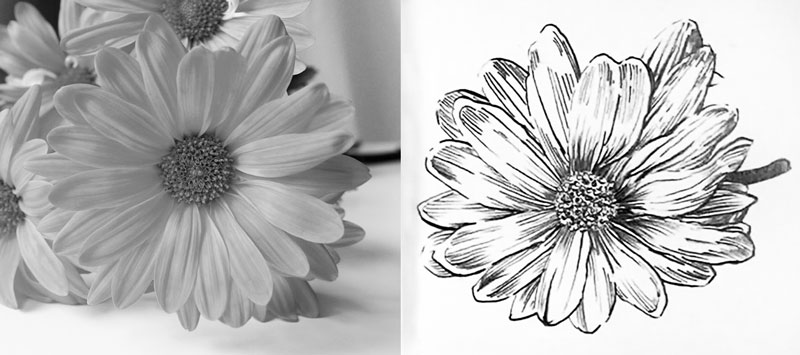
The drawing above is role of "Cartoon Bootcamp". Click here to view Cartoon Bootcamp (Membership required).
As nosotros tin can see, line is great for describing a subject in a cartoon, just outlines on their own are not complete. Other elements of art (specifically value) must be used in improver to line to create a realistic drawing.
Lines that are used to communicate the edges and/or to describe the details of a subject (similar nosotros see above) are called contour lines. We commonly call these lines outlines.
Line Quality
Line quality refers to the characteristics of the line drawn. In many cases, line quality refers to the thickness of a line. By varying the line quality (including both thick and sparse lines), we create drawings that are more interesting and provide more information to the viewer.
Take a look at the line drawing of the apple tree below. Observe how the contour lines are thicker in areas. A thicker line is used where we expect to see shadow and where the apple itself is a little thicker.

In this mode, we can communicate a scrap about the form of the apple and the light using a simple line.
Cross Contour Lines
Cantankerous profile lines are more than circuitous than profile lines. Cross contour lines menstruum over the form of the subject. These lines tin can be implied or visible. Cross contour lines are by and large used when line is used to shade a drawing with hatching and cross hatching.
To meliorate understand cross profile lines, you may imagine running your finger over the surface of an apple tree. Showtime from the stem and motility downward to the bottom. Equally yous move your finger, imagine leaving a line behind. If you proceed repeating this, making "lines" with your finger all effectually the apple, yous would have created cantankerous contour lines.
We can see this illustrated in the image beneath...

The importance of understanding the concept of cantankerous contour lines lies in shading (or adding shadow and highlight) with line. Depending on the form of the object you are drawing, these lines may bend or change direction.
For more on cross contour lines, run into the post-obit lessons...
- Cantankerous Contour Lines - 25 Days to Better Drawings (Membership required)
- Line and Value - The Pen and Ink Experience (Membership required)
- How to Use Cross Contour Lines to Create the Illusion of Form
Shading with Line
Line can be used to shade drawings as well. Shading is the process of developing the value (art chemical element). Value is the darkness or lightness of a color. Darker values typically represent shadows while lighter values typically represent highlights or lighter tones.
Lines can be concentrated to create darker values. The more than lines that are used, the darker the perceived value. Lighter tones can exist achieved by allowing more of the white of the paper to evidence through or with less concentrated lines.
We can see this concept illustrated in the image below. The pepper has been shaded using lines. In areas where the value is darker, more than lines are used. In areas where the value is lighter, less lines are used. You'll likewise notice that line quality (variety in line thickness) is also used to create a more than interesting drawing.
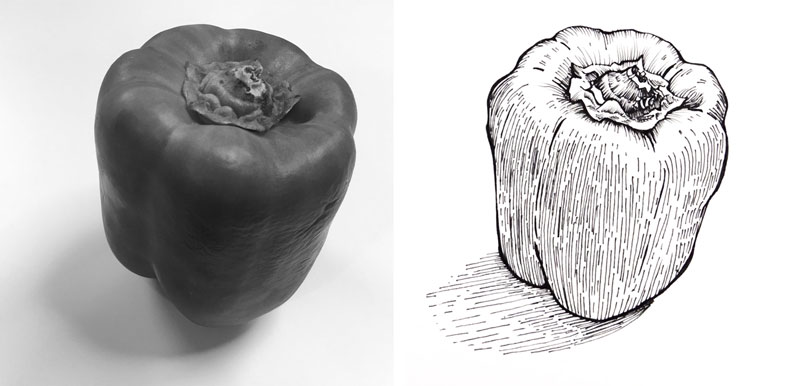
The drawing above is part of "25 Days to Better Drawings". Click hither to view 25 Days to Meliorate Drawings (Membership required).
You'll also notice that the lines used to shade the drawing curve and change direction slightly based on the form of the pepper. This illustrates the concept of cross contour lines discussed earlier.
Hatching
Hatching is the procedure of using directional linear strokes that do not cantankerous over each other to develop the shading in a drawing.
Hatching tin can exist used with any cartoon or painting medium simply it is at its best when used with linear drawing medium. Below nosotros tin run across a drawing that was created with pen and ink that utilizes hatching.
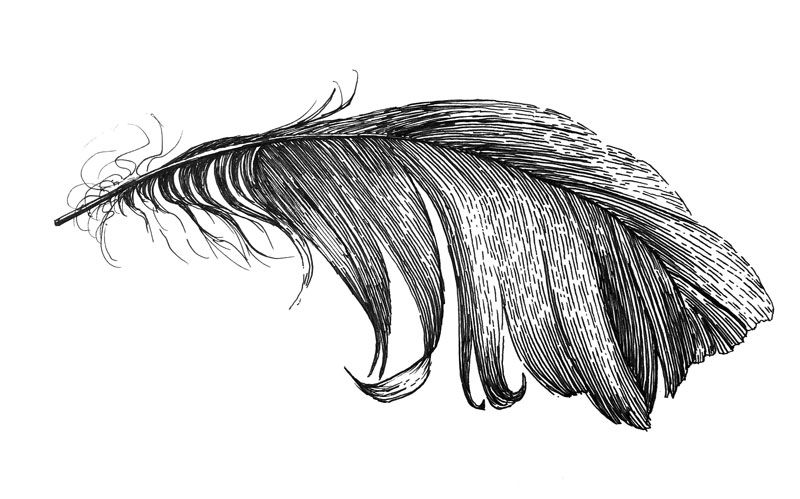
The drawing above is part of "Subjects with Pen and Ink". Click here to view Subjects with Pen and Ink (Membership required).
Cantankerous Hatching
Cross hatching is the process of developing the value (or shading) in a drawing or painting using lines that cross over each other. Just similar with hatching, the greater the concentration of marks, the darker the value. Hatching and cross hatching are oftentimes used together.
Beneath, you'll find a drawing created with pen and ink that utilizes cross hatching.
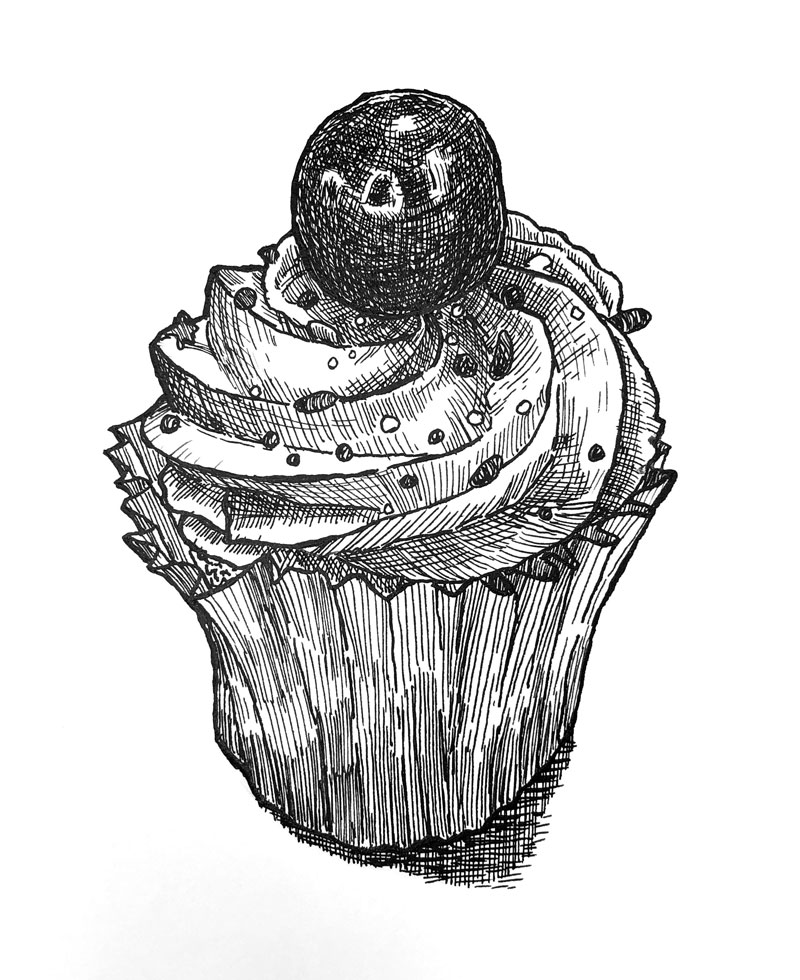
The cartoon above is role of "Subjects with Pen and Ink". Click here to view Subjects with Pen and Ink (Membership required).
Types of Lines
Lines come in all shapes and sizes and the types of line that tin can be drawn are endless. Some common forms of line include horizontal, vertical, diagonal, zigzag, and curved. Other types of line include broken lines and implied lines.
Horizontal lines are lines that are parallel to the horizon and mostly flow from left to right or vice versa.

Vertical lines are lines that move up and downwards without any slant.

Diagonal lines are lines that camber.

Zig zag lines are lines that change direction abruptly.

Curved lines gradually change direction.

Broken lines include open spaces merely go on on a path. These lines may imply an border or be used to communicate a highlight.

Implied lines may include the open infinite in between broken lines. These lines may non exist visible just are implied due to dissimilarity in value or the inclusion of broken lines.
Run across also: Implied and Broken Lines
Line - Vocabulary Terms
Line - element of art. In terms of fine art, line tin can be described every bit a moving dot. Line is possibly the about bones element of drawing.
Line Variation - the use of a variety of line including width, length, texture, thickness, etc. to add interest to a drawing or painting.
Length - lines can be long or short.

Width - lines can be wide or skinny.

Texture - lines tin be crude or smooth.

Management - lines can move in whatsoever direction.
Caste of curve - lines can bend gradually or not at all.
Hatching - lines that flow in the same management in gild to develop value or shading
Line quality or line weight - refers to the thickness or thinness of a line. By varying the line quality artists tin can make objects appear more 3-dimensional and more interesting.
Crosshatching - lines that cross over each other in lodge to develop value or shading.
Source: https://thevirtualinstructor.com/line.html
Publicar un comentario for "Lines Can Be Used in Art to Indicate Which of the Following Check All That Apply"